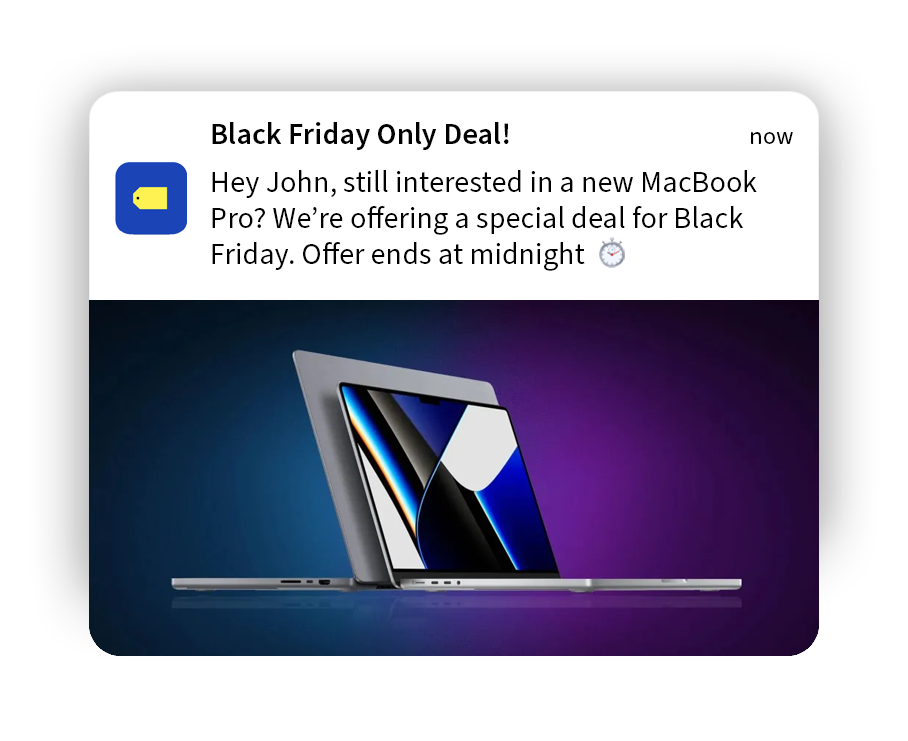As Black Friday and Cyber Monday (BFCM) approach, it’s time to gear up for one of the year’s biggest shopping extravaganzas. This four-day fest of the internet’s biggest deals offers marketers an incredible opportunity to capture the attention of eager customers.
Mobile continues to prove itself as a critical channel for engaging holiday shoppers. Last year, shoppers spent a record $9.12 billion online during Black Friday, with 55% of sales coming from mobile devices.
But when a sea of brands are competing simultaneously for customers’ attention during the busiest event of the year, how do you ensure you make your mark?
We’ve got you covered with five push notification best practices to help you stand out and connect with your audiences this Black Friday.
Choose the right push notification power words
The language you use can make or break your Black Friday messaging. If it doesn’t stand out from your competitors and other brands vying for your users’ attention, your pushes can quickly become lost in the overall BFCM bombardment.
The key terms that perform best during Black Friday sales include:
- Deals
- Last chance
- X% off
- Save
Keep your messaging simple and concise. Users receive a multitude of communications between Black Friday and Cyber Monday, so you realistically only have a few seconds to grab your customers’ attention and convince them to take action. A/B testing your campaigns can help refine your messaging and identify the keywords that resonate most with your target audience.
A/B testing your campaigns can help refine your messaging and identify the keywords that resonate most with your target audience.
Use GIFs and emojis in your messaging
Adding emojis and GIFs to your campaigns adds a fun and personal touch that contributes to the tone and emotion of your brand. Because they are an untapped feature of push campaigns, they effectively grab users’ attention and are much more memorable than standard push messages. Used daily by smartphone users among their friends and family, GIFs and emojis help build a connection with your customers and lead to higher engagement. Emojis related to the holiday season have seen an impressive 3X improvement in open rates. To understand the real value they add to your unique audience, you can try A/B testing the same message with and without emojis and compare the engagement results. Experiment with static images versus animated GIFs to compare the impact each has on your campaign performance.
Emojis related to the holiday season have seen an impressive 3X improvement in open rates. To understand the real value they add to your unique audience, you can try A/B testing the same message with and without emojis and compare the engagement results. Experiment with static images versus animated GIFs to compare the impact each has on your campaign performance.
Recover abandoned carts with triggered push
With hundreds of exclusive deals competing for customers’ attention, purchase flows can become more interrupted than usual during the Black Friday period. And with online traffic at its peak, we naturally see higher rates of abandoned purchases. To help overcome this challenge and maximize cart recovery, you can use triggered push notifications to automatically retarget users who leave items in their cart. Your users are likely comparing prices and brands to seek the best deals on their cart items, so what can you do to encourage them to return and convert? Consider offering incentives like free shipping, and discount codes or creating a sense of urgency if the item is in high demand and selling fast.
To help overcome this challenge and maximize cart recovery, you can use triggered push notifications to automatically retarget users who leave items in their cart. Your users are likely comparing prices and brands to seek the best deals on their cart items, so what can you do to encourage them to return and convert? Consider offering incentives like free shipping, and discount codes or creating a sense of urgency if the item is in high demand and selling fast.
Send time-sensitive promotions
Many people hold off on purchasing specific products during the year, hoping to snap up a better deal around Black Friday. As soon as November arrives, customers wait in eager anticipation for the sales to launch and prices to drop.
The increase in online shopping (55% of all Black Friday shoppers made their purchases online in 2022) has reduced the frantic in-store dashes to snatch up the best deals, but it’s still possible to replicate this same urgency for e-commerce. You can instill a sense of urgency and exclusivity with promotional push notifications so customers know they are getting a great deal. Emphasize the time-sensitive nature of your offers in your messaging to maximize conversions during this peak discount period.
You can instill a sense of urgency and exclusivity with promotional push notifications so customers know they are getting a great deal. Emphasize the time-sensitive nature of your offers in your messaging to maximize conversions during this peak discount period.
Many sale items quickly run out of stock, so you can also use this opportunity to inform customers they should act fast if they are to avail of these short-term offers. Delivering tactical push messages like this can be the deciding factor for many customers still weighing up their options and comparing among multiple brands.
Use push to attract nearby users to your stores
If your users are out and about during Black Friday weekend, they’re likely doing some in-person shopping. That’s not to say they won’t also shop online, but if they are physically on the go and near your premises, it’s a prime opportunity to promote your in-store Black Friday deals, especially if an offer or experience is exclusive to brick and mortar.
Use your customers’ location data to trigger timely notifications about your Black Friday offers when they are within a specified distance from your physical store.
For example, a coffeehouse could have a merchandise sale online and a drinks promotion in-store. A department store could offer complimentary gift wrapping or a barista serving coffee to customers while they browse—experiences that are not available online.
Crush your Black Friday marketing with mobile push messaging
Black Friday is a huge opportunity for brands to engage highly motivated shoppers actively searching for deals. Take advantage of the biggest traffic-driving event of the year through tactical push messages that highlight your best deals, remind customers about items in their cart, and entice them with exclusive in-store offers.
Accurately tracking and analyzing your campaigns will provide you with better insight into what worked, what didn’t, and why. This data will help shape your strategy for next year and ensure you’re well-positioned to optimize your message content, timing, and audiences.
Push notifications are an essential channel for engaging users all year round—during the holiday season and beyond. Learn how some of the world’s biggest mobile-first brands deliver perfectly timed, personalized messaging to their mobile and desktop app audiences using MessageGears.





